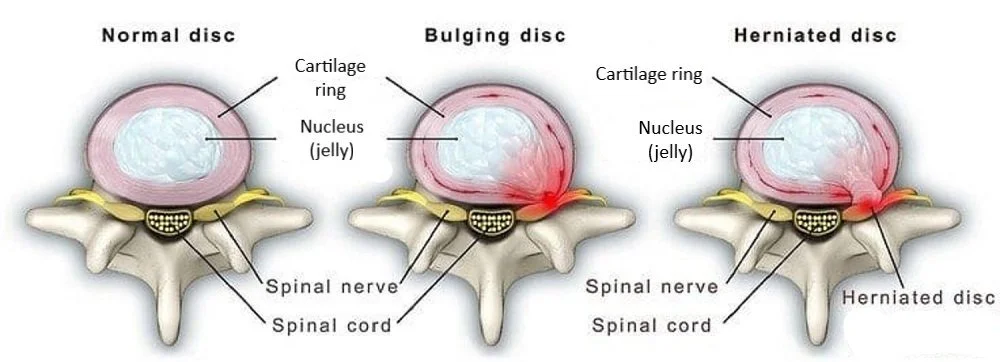Recovering from a Lumbar disc injury
A disc bulge or prolapse can occur in the neck, mid-back or lower back. The lowest lumbar discs (L4/5 and L5/S1) take the most weight and often form a ‘hinge point’ for movement of the trunk. By far the majority of lumbar disc injuries occur at these two levels.
A disc bulge occurs when a weakness in the outer wall (the annulus fibrosis) allows the disc to change shape. The material on the inside (the nucleus pulposis) bulges outwards deforming the outer wall, which may put pressure on sensitive surrounding structures including the nerve roots. This is a common and less severe form of disc injury.
A disc herniation (also called a disc prolapse) occurs when pressure on the disc causes the softer nucleus material to crack the outer wall of the disc and leak out.
Symptoms
With a minor lumbar disc bulge or herniation, pain will be localised to the lower back, possibly radiating to the buttock or thigh at times. The pain is usually worsened by prolonged sitting, bending, or simply staying in any one position for too long. In more severe cases, pain may extend down the leg on one or both sides, or alternate sides, sometimes as far as the foot. The pain may be constant or may come and go.
If the disc impinges on a nerve root, there maybe be neurological signs such as numbness, pins and needles or loss of power in parts of one or both legs. People with significant neurological symptoms may have to consider surgery, however surgery poses significant risks and in most cases it is worth trying less invasive approaches first.
Can a disc heal?
Now the important question about the disc. Can it heal? YES. A major prolapse or herniation may not heal by itself and surgery may be advisable in some cases, but potentially a bulge and small to moderate sized prolapses can be healed by the body’s own repair processes in time. How long? That depends on how severe and how unstable it is, your age and most importantly how much stress you put on it, which is the part you can control. It also depends on the state of your spinal and abdominal muscles, as weakness or imbalances in these may be part of what caused the problem in the first place.
With a disc bulge, the walls of the disc are still intact, and healing time is shorter, though in some cases it can still take months. With a disc herniation (prolapse) it can take many months or even years to resolve.
Once you injure your disc, it will be unstable for a period of time (months or years for a severe prolapse). This means that the disc will bulge a lot more than usual when you are weight-bearing (eg standing, sitting, bending, lifting) and typically gets worse as the day goes on. An unstable disc is more likely in a young or middle aged person because as you get older the disc dehydrates and the nucleus becomes more rigid – stiffer but more stable. Young people may heal quicker after a disc injury due to tissue repair processes.
What Happens if a Bulging Disc Goes Untreated?
Even if you don’t seek professional treatment, nature will naturally heal your bulging disc. While professional spinal care may fast-track your recovery, most instances of mild bulging discs will heal naturally and may not require treatment. However, patients suffering from a bulging disc commonly seek quicker pain relief. In these instances, please seek out the professional advice of your trusted spinal healthcare practitioner (Chiro, physio or osteo).
Chiropractic care for disc injury can include:
Spinal adjustments
Muscle relaxation techniques
Home stretches and exercises
Postural correction
Disc herniations are a common condition that Chiropractors treat in practice. If you choose to see a Chiropractor, they will be able to provide appropriate recommendations to reduce pain and get you moving, feeling, and functioning better overall.
Contact us for more information about your back pain.


